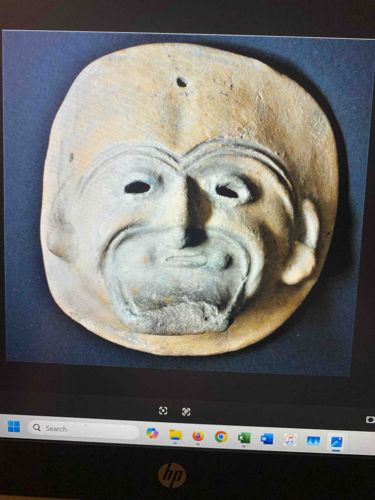
Jama Coaque Ceremonial Maskette
This artifact is a Jama Coaque ceremonial maskette, originating from Ecuador, dated to approximately 400 BCE - 500 CE. It is constructed from what appears to be a light-colored, possibly terracotta or ceramic material, exhibiting a matte, earthy finish with variations in tone ranging from a pale beige to light tan, suggesting inherent material characteristics or possibly residual soil/patina. The maskette is roughly oval in shape, with dimensions stated as approximately 5.5 inches in height by 5.75 inches in width. The facial features are distinctly rendered in a stylized manner. The eyes are almond-shaped openings, deeply set, with prominent brow ridges sculpted above them. There are incised lines or grooves defining the upper eyelids and eyebrows, adding to the expressive quality. The nose is broad and flat, with a simple, defined septum and nostril area. A notable feature is the 'very pronounced chin,' which extends forward, giving the face a somewhat elongated or jutting profile. The mouth is rendered as a wide, open cavity, adding to the ceremonial or expressive nature. The ears are indicated as flattened, slightly raised forms on the sides of the head. A single, small, circular perforation is visible at the top center of the forehead, likely intended for suspension or attachment, indicating its function as a maskette rather than a full-sized mask. In terms of condition, the maskette shows signs of professional restoration, suggesting prior damage. Despite restoration, some chipping is still visible, particularly on the prominent chin, indicating the fragility of the material or residual wear from its ancient origin. The surface exhibits a natural, aged patina consistent with its estimated age, with areas of darker discoloration or encrustation, especially within the recessed features like the mouth and chin area, which may be original sediment or environmental staining. The craftsmanship appears hand-modeled, and while stylized, demonstrates a clear artistic intent and cultural aesthetic characteristic of the Jama Coaque people.
AI-Generated Appraisal Disclaimer
Estimated Value
$3,000-5,000
Basic Information
Category
Archaeological Artifact - Maskette
Appraised On
November 29, 2025
Estimated Value
$3,000-5,000
Additional Details Provided By Owner
User Provided Information
Jama Coaque ceremonial maskette, Ecuador, ca. 400BCE - 500CE. Very pronounced chin. Professionally restored with some chipping on chin remaining. Approximately 5.5” x 5.75”
Item Description
This artifact is a Jama Coaque ceremonial maskette, originating from Ecuador, dated to approximately 400 BCE - 500 CE. It is constructed from what appears to be a light-colored, possibly terracotta or ceramic material, exhibiting a matte, earthy finish with variations in tone ranging from a pale beige to light tan, suggesting inherent material characteristics or possibly residual soil/patina. The maskette is roughly oval in shape, with dimensions stated as approximately 5.5 inches in height by 5.75 inches in width. The facial features are distinctly rendered in a stylized manner. The eyes are almond-shaped openings, deeply set, with prominent brow ridges sculpted above them. There are incised lines or grooves defining the upper eyelids and eyebrows, adding to the expressive quality. The nose is broad and flat, with a simple, defined septum and nostril area. A notable feature is the 'very pronounced chin,' which extends forward, giving the face a somewhat elongated or jutting profile. The mouth is rendered as a wide, open cavity, adding to the ceremonial or expressive nature. The ears are indicated as flattened, slightly raised forms on the sides of the head. A single, small, circular perforation is visible at the top center of the forehead, likely intended for suspension or attachment, indicating its function as a maskette rather than a full-sized mask. In terms of condition, the maskette shows signs of professional restoration, suggesting prior damage. Despite restoration, some chipping is still visible, particularly on the prominent chin, indicating the fragility of the material or residual wear from its ancient origin. The surface exhibits a natural, aged patina consistent with its estimated age, with areas of darker discoloration or encrustation, especially within the recessed features like the mouth and chin area, which may be original sediment or environmental staining. The craftsmanship appears hand-modeled, and while stylized, demonstrates a clear artistic intent and cultural aesthetic characteristic of the Jama Coaque people.
Get Your Items Appraised
Instant estimates of your treasures with AI-powered instant appraisals